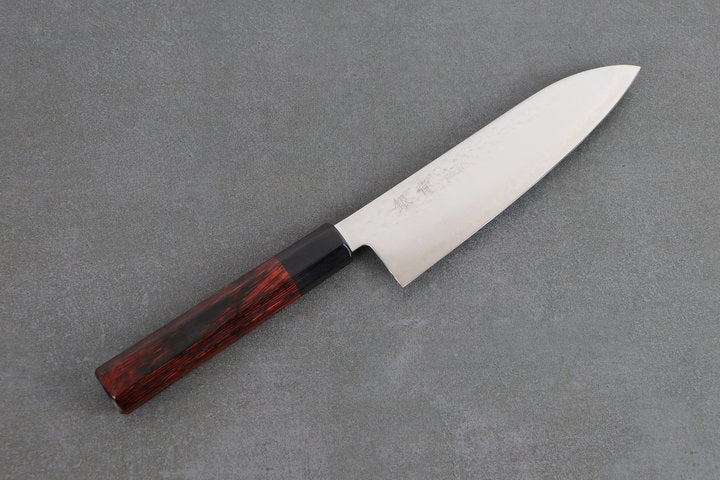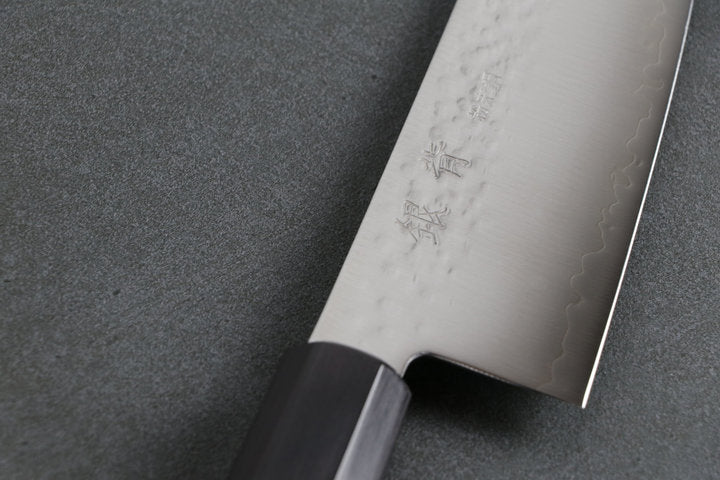Santoku Knives
Santoku knife translates to "knife of the three virtues". With this translation, Santoku chef's knives are already well described as they are equally suitable and proven for cutting meat, fish and vegetables. The Santoku is the perfect all-purpose knife and accordingly widely used!
The Santoku knife is a very common Japanese blade shape for all-purpose kitchen knives. The wide blade of the Santoku provides enough space for the fingers under the handle and allows the blade to be neatly guided at the back of the fingers of the other hand while cutting. Santoku knives are best suited for precise and speedy chopping of meat, fish and vegetables into fine strips. The blades of Santokus typically have a blade length between 160mm and 180mm and can therefore also be used for larger cut material. At Silverback Knives you will find hand forged Santoku knives from traditional cutlers. The high blade and the curved tip, also called Kamagata tip, make these knives a perfect for all purposes. The blade shape of a santoku knife allows the use of different cutting techniques, for example the rock chopping (rolling over radius of the tip), or the chopping technique, for example for processing herbs with the straight blade area near the handle.
The Santoku knife is a very common Japanese blade shape for all-purpose kitchen knives. The wide blade of the Santoku provides enough space for the fingers under the handle and allows the blade to be neatly guided at the back of the fingers of the other hand while cutting. Santoku knives are best suited for precise and speedy chopping of meat, fish and vegetables into fine strips. The blades of Santokus typically have a blade length between 160mm and 180mm and can therefore also be used for larger cut material. At Silverback Knives you will find hand forged Santoku knives from traditional cutlers. The high blade and the curved tip, also called Kamagata tip, make these knives a perfect for all purposes. The blade shape of a santoku knife allows the use of different cutting techniques, for example the rock chopping (rolling over radius of the tip), or the chopping technique, for example for processing herbs with the straight blade area near the handle.
Sharpening Santoku Knives
Hand-forged Japanese knives are best sharpened with whetstones. Our Santoku knives should also be sharpened with these grinding accessories. Our robust natural water whetstone is suitable for fine sharpening. For experienced users of sharpening stones we also have somewhat more sensitive stones in our range (sharpening stone set professional), which allow you to bring out the full potential of the Japanese knife steel of a Santoku knife. Our range of sharpening stones covers all requirements from basic sharpening (somewhat coarser grain of the sharpening material) to fine sharpening (ultra-fine grain of the sharpening stone). Which stone should be used depends on the condition of the blade. If a Santoku knife has a very worn blade, a basic grind should be made first, followed by the fine grind. If blades are used and sharpened regularly, it is usually sufficient to use a fine to ultra-fine grit for fine sharpening. In any case, we do not recommend the use of sharpening rods or sharpening steels. These sharpening tools are not suitable for Japanese knife steel and should therefore not be used on Santoku knives either!
The Best Santoku Knife and which Santoku Knife to buy?
As individual as each person's demands on their kitchen knives are, the question of the best Santoku can also be answered differently. However, to decide for yourself which knife suits you best, there are some criteria you can pay attention to:
How often is the Santoku Knife used?
As a general-purpose knife, a Santoku is usually used very regularly. From our point of view, a good Santoku knife should be part of the basic equipment in any kitchen. Accordingly, you should pay attention to the quality of workmanship when choosing, because only a well-made Santoku gives the cook long pleasure. All knives in our store are made by traditional cutlers and, with proper care, are a very durable tool.
What is a Santoku Knife used for?
The Santoku knife is very versatile and can be used for fish, meat and vegetables. So if you are looking for an all-purpose knife for the basic equipment in the kitchen, you are exactly right with a Santoku. The blade length of about 16cm - 18cm reflects these all-rounder qualities. With this size, the Santoku knife can handle somewhat larger cuttings as well as more delicate work, such as cutting vegetables into fine strips.
The Sharpness of the Santoku Knife
Sharpness is clearly one of the most important criteria when choosing your Santoku. In this context, the edge retention also plays a major role, determining how long a Santoku knife will retain its sharpness. Basically, carbon-rich steels are harder and sharper than steels with a lower carbon content. The hardest and sharpest steels include all Shirogami and Aogami steels. Slightly lower levels of hardness are offered by the low-maintenance steel grades VG10, AUS10 and Gin 3 (Silver 3).With the knife steels ATS-34, HAP40 and ZDP189, the market has been reached by steels that combine the advantages of the worlds of high-carbon and low-carbon steel grades: Due to their hardness, they offer excellent sharpening potential and at the same time are hardly susceptible to corrosion. In our store you will find Santoku knives with different core steels to meet the individual requirements of our customers.
The Appearance of the Santoku Knife
The appearance of the Santoku can also be decisive for a purchase. The steel used, the surface finish as well as the surface structure of the blade and the handle are determining factors for the knife's look. The blade shape is very similar for all Santokus. Depending on your personal taste, you can find Santoku knives with very different looks in our store. Some customers consider a Japanese knife to be a collector's item and therefore go for very artistically produced Santoku knives with a special surface structure (e.g.: Tsuchime or Kurouchi finish). However, santoku knives that are designed for performance and robustness are available as well.
Ergonomics of the Santoku Knife
As all-purpose knives, Santokus are usually used on a very regular basis. Therefore, it is of course important to ensure that you work with a knife that you feel comfortable with. The balance of the knife, the handle (or the feel and shape of the handle) as well as the weight and length of the knife are mainly decisive for this feeling. All Santoku knives in our store are excellently balanced, which allows the knives to be wielded very cleanly and precisely. The handle is in the end a matter of taste. Some customers prefer natural handles without edges. Other customers, on the other hand, prefer lacquered handles that are octagonal in design. The Santoku knives in our store have blade lengths between about 16cm and 18cm, making them perfect all-purpose knives for most cutting tasks. With these blade lengths, the Santoku is still relatively compact, but larger items such as a head of cabbage or larger pieces of meat can still be cut precisely. The weight of a Santoku knife also depends to a large extent on the used steel. There is a wide range in that regard for example, the Santokus from Misuzu feel light as a feather at just under 100 grams. A Kisuke ATS-34 Santoku knife, at just over 160 grams, feels much heavier in the hand. Ultimately, it is once again a question of personal taste, which variant of a santoku knife one chooses.
Which Santoku Knife to buy?
You should buy the Santoku knife that best meets your own wishes. As a small guideline, the above-mentioned criteria of frequency of use, quality of workmanship, intended use, sharpness and edge retention, ease of care, appearance and ergonomics can be used. At Silverback Knives you will find the right Santoku knife for every taste.
Santoku Knife Care
The care of a Santoku knife depends largely on the blade steel used. High-carbon steels (Aogami, Shirogami) are more susceptible to corrosion than lower-carbon steels. This means that with high-carbon it is essential to clean and dry the blades quickly after use. Japanese Santoku knives should be stored in a dry place and should never be cleaned in a dishwasher (by the way, this also applies to conventional Western knives!). Wooden boards and plastic pads are best suited as cutting surfaces. On glass and stone, marble, etc. the steel of the Santoku wears out faster.



